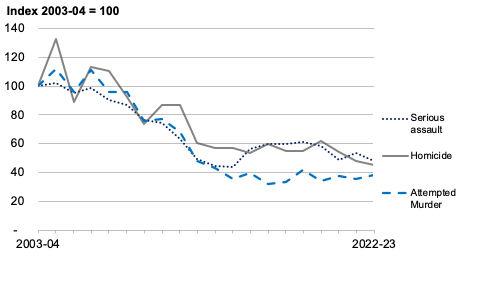Homicide in Scotland 2022-23
Statistical bulletin on crimes of homicide recorded by the police in Scotland in 2022-2023.
Comparator statistics
Table 4
This bulletin has reported a decreasing trend in homicides over the longer term. Figure 10 shows this trend over the last 20 years and compares it to the trend in attempted murder and serious assaults. This information is taken from the recorded crime in Scotland bulletin Recorded Crime in Scotland, 2022-23 - gov.scot (www.gov.scot). It shows that over the longer-term trends in homicide have matched other violent crimes, having fallen over a ten year period before 2013-14, they have remained relatively stable over the most recent ten year period.
Figure 10: Trends in homicide, follow trends in other non-violent sexual crime

Similar to Scotland, England & Wales also produce National Statistics on Homicide, which is extracted from a dedicated database - the Home Office Homicide Index. The latest data published is for the 2021-22 reporting year available at Homicide in England and Wales - Office for National Statistics (ons.gov.uk).
Direct comparisons between Scotland and England & Wales should be treated with some caution due to uncertainty around different counting and classification conventions.
Further to this, users should note that in England & Wales, as in Scotland, it is possible for homicides that occurred sometime in the past to be recorded in more recent years. For example, whilst the data for 2022-23 are not yet available, the Office for National Statistics (ONS/) has previously highlighted that earlier figures for 2016-17 included the 96 victims of Hillsborough which occurred in 1989, representing 14% of all victims in 2016-17.
One area where some general comparisons can be made are the broad trends in changes over time between Scotland and England & Wales, though still allowing for the caveats outlined above.
In Scotland, the number of homicides has fallen over the longer term but remained relatively stable during 2012-13 to 2020-21 (with between 59 and 66 victims each year) before falling to an, at the time, record low of 53 homicides in 2021-22. The latest publication for 2021-22 reported that in England & Wales the number of homicides recorded in the year ending March 2022 was 23% higher than the previous year, but similar to the four pre-pandemic years from the year ending March 2017 to the year ending March 2020.
One notable difference between Scotland and England & Wales relates to the age of homicide victims. As reported elsewhere in this bulletin, there has been a steep fall in the number of homicide victims in the 16-24 age group in Scotland over the past 20 years. This trend has not been seen in England & Wales.
- Over the 5 years between 2017-18 and 2021-22 the average rate of homicide for the 16-24 age group in Scotland was 10 per million population per year, slightly lower than the rate for the whole population (11 per million population). (Table 5).
- The average homicide rate for 16-24 year olds in England & Wales for the five years from 2017-18 to 2021-22 was 19 per million population, substantially higher than the average rate for the whole population (11 per million population).
Contact
Email: justice_analysts@gov.scot
There is a problem
Thanks for your feedback